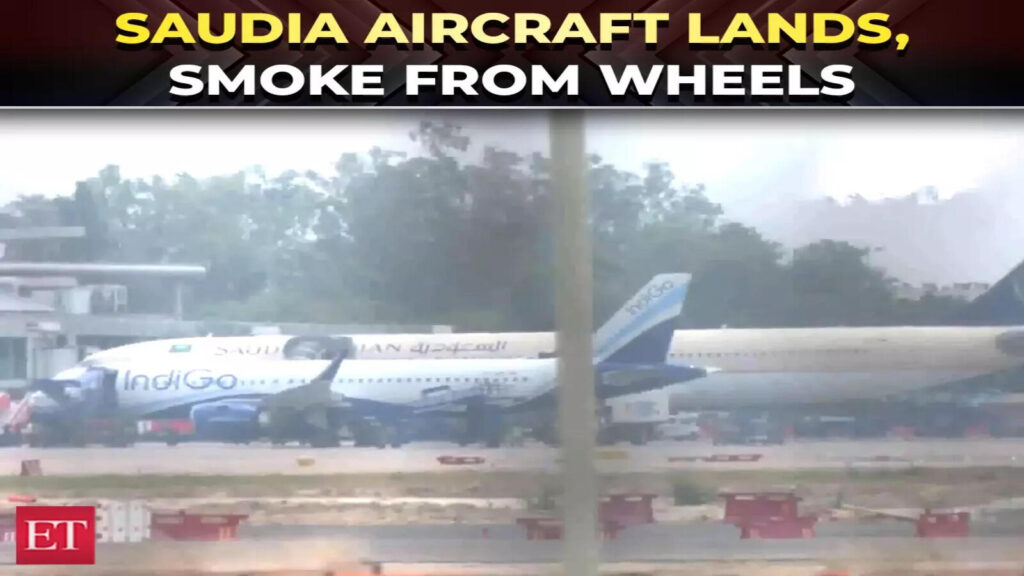Smoke emerged from the left-side landing gear of a Saudia Airlines Airbus A330-343 shortly after its touchdown at Lucknow’s Chaudhary Charan Singh International Airport on Sunday morning. The aircraft, Flight SV 312, had departed from Jeddah carrying approximately 242 pilgrims returning from the Hajj. There were no injuries among passengers or crew, and airport operations continued without interruption.
Airport Rescue and Fire Fighting teams swiftly responded to the alert, in coordination with Saudia’s technical crew. They treated the situation as a precautionary measure, confirming that the smoke was contained before any damage occurred. Airport officials have described the episode as minor and fully under control.
Initial technical assessments indicate that the smoke originated from hydraulic fluid leakage in the braking system or landing gear assembly. Hydraulic systems are critical for wheel braking and gear retraction; even a small leak can generate heat and smoke during the high friction conditions of landing.
Flight-tracker data shows SV 312 took off from Jeddah at 10:45 pm local time on Saturday and landed at around 6:50 am on Sunday, operating on a scheduled pilgrimage route consistent with Hajj flights. Aviation analysts note that scheduled technical inspections are carried out before and after such operations, and that tyre or brake overheating can occur without immediate failure when detected early.
The airline has not issued a public statement, but airport sources confirm that Saudia’s maintenance team is fully cooperating with investigators. An internal and regulatory-level probe has been initiated to determine the root cause, with engineers examining the hydraulic lines, brake units, and thermal sensors to rule out broader mechanical or procedural lapses. Investigators will also review cockpit logs and telemetry data to verify if onboard warnings were triggered during landing or taxi.
Lucknow airport authorities emphasised that emergency preparedness paid dividends, citing coordinated action between airport fire services and airline technicians. “There was no impact on normal flight operations,” an official said, underlining that all passengers disembarked safely and continued their onward journeys without disruption.
The occurrence comes amid heightened scrutiny of aviation safety protocols in the region. Last month, aviation regulatory bodies and operators began intensified safety drills following unrelated incidents at several Indian airports. While none were connected to Saudia, this event underscores the importance of maintaining high safety readiness levels. An aviation expert commented that routine post-landing inspections likely detected indicators before any escalation. No regulatory advisory or ground-stop orders have been issued, as the probe remains confined to this aircraft.
Passenger accounts corroborate the official narrative. A pilgrim waiting outside the terminal described smoke plumes rising from the undercarriage as the plane taxied to gate, after which ARFF personnel applied foam and inspected the wheels. “It looked alarming, but the crew remained calm and assured us everything was checked immediately,” the pilgrim said. Similar testimonies were noted in media reports, but none pointed to panic onboard.
This incident follows earlier cases internationally where hydraulic leaks in braking systems led to wheel smoke or minor tyre fires post-landing. In most cases, emergency teams intervened before structural damage occurred. Aviation safety specialists view these events as validation of emergency response effectiveness when procedures are adhered to promptly.
Saudia Airlines operates daily flights between Jeddah and Lucknow during the Hajj season, serving thousands of Indian pilgrims. The airline liaised closely with the Indian Directorate General of Civil Aviation and airport operators in advance to ensure all safety measures were in place. Though Hajj flights typically carry large contingents, transport records show that flights from Lucknow have maintained an incident-free record for the past five years.
In compliance with DGCA regulations, Saudia has scheduled follow-up inspections of its Hajj-dedicated fleet. These include hydraulic system integrity assessments and brake thermal performance tests. Airline maintenance logs and crew check reports from the Jeddah departure will be scrutinised as part of the inquiry.
While the investigation continues, aviation stakeholders emphasise that reported brake or gear smoke does not always signal imminent danger. Braking systems can generate smoke under high energy transfer situations, especially if fluid is heated or leaks onto hot surfaces. When detected early by pilots and ground teams, the risk can be mitigated swiftly. This incident is now being cited as a case study in emergency readiness rather than a systemic lapse.
Lucknow airport saw no delays in inbound or outbound flights, and runway operations proceeded as scheduled. Airport officials confirmed there were no runway closures or diversions related to the incident. The Saudia aircraft, after deboarding, was cleared for a subsequent empty repositioning flight later that day.
The probe aims to verify if any maintenance oversight existed, such as delayed hydraulic fluid change or worn brake components. DGCA and the airline will jointly review whether enhanced pre-landing checks are warranted for future Hajj services, particularly given the high turnaround volume at Lucknow during the pilgrimage season.




 White House Hosts Pak Army Chief Amid South Asia, Middle East Crisis
White House Hosts Pak Army Chief Amid South Asia, Middle East Crisis 